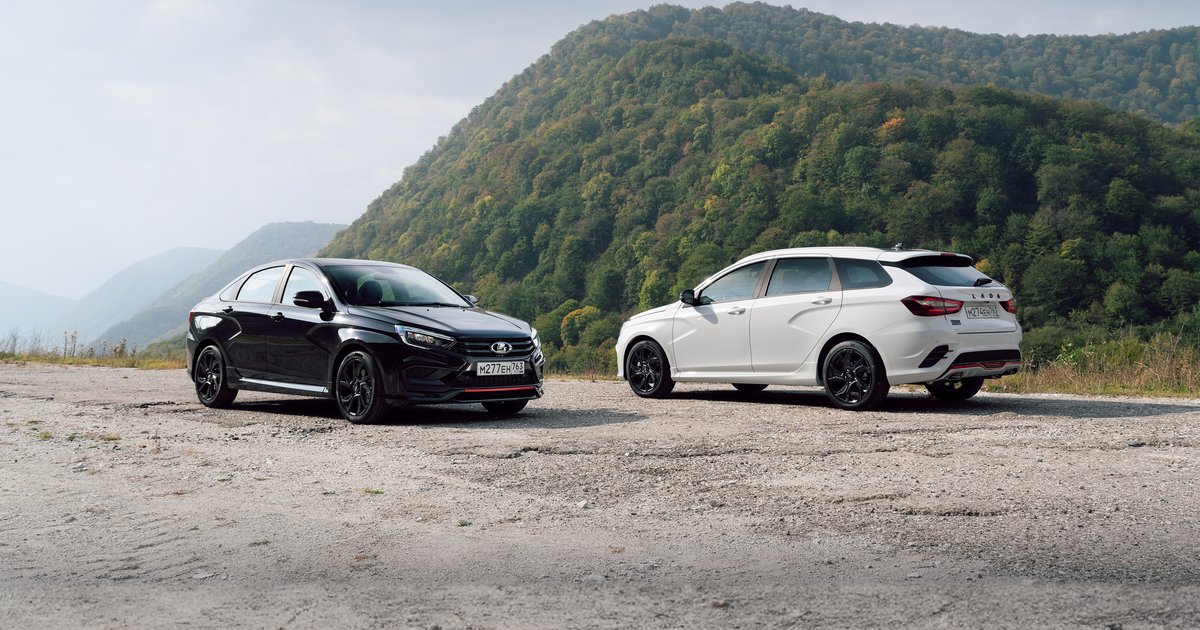The sports department of the auto industry giant from Tolyatti has expanded the line of Vesta modifications with an interesting version
“The higher the mountains, the lower the Priors!” – these words of Timati’s famous track are really relevant in the Caucasus. Therefore, the line of Lada Vesta Sportline sedans and station wagons parked in the capital of the Chechen Republic gathered onlookers around them and caught interested glances from passing cars. Of course, all Sportlines have lowered suspension and widened front fenders and are currently painted in only two colors: white and black. Just like the “Prior”, previously produced at the Chechen-Avto enterprise. This means we are in the right place. And a test drive of the Lada Vesta Sportline along serpentines convincingly answered the question of whether this version will be in demand.
Ground clearance is reduced by 20 mm and is 158 mm. Of course, the lowered Lada Vesta Sportline looks much better than the regular versions
Bet on black
Lada Vesta after restyling has become prettier due to new LED headlights and sharply defined taillights, but Sportline holds the eye much longer. The low bumpers with wide air intakes immediately catch your eye – by the way, the aerodynamic body kit was blown in the factory pipe and reduces lift by 61% for the sedan and 28% for the station wagon (yes, there is also a SW version).
The swollen front fenders are made of plastic (the front track is widened by 18 mm) and also add sporty aggression to the Vesta’s appearance. 17-inch wheels with Pirelli P7 Cinturato tires of size 205/50 R17 are secured with 5 bolts. At the rear there are two exhaust pipes at the edges of the bumper and a spoiler “tail” on the trunk lid, exactly the same as that of the “Super Production” class racing “Vesta” of the Russian Circuit Racing Series (RSKG). Doesn’t remind you of anything? Of course, this is what the old Lada Vesta Sport looked like!
The final stage of the RSKG took place in Chechnya, where Mikhail Mityaev from the Lada Sport Rosneft team won the Russian Cup in the “Superproduction” category, and Ivan Chubarov was only 1 point short of winning the most prestigious TCR Russia class. So the Lada sports department has plenty of experience in preparing equipment.
The Black package is also available for the Sportline – not only the roof and side mirrors will be painted black, but also the wheels, trunk with spoiler and nameplates. And such a car looks more interesting than with chrome letters.
Inside there is a black ceiling and cool seats with red inserts and Lada Sport embroidery. By the way, unlike the new Granta Sport that we recently tested, which doesn’t even have remote control for door locks, Vesta Sportline is created on the basis of the maximum Techno configuration – there is a screen instead of an instrument panel and a large tablet with Yandex services.
What does Lada Granta Sport have to do with it?
It is not mentioned by chance. Under the hood of the Sportline is the same 1.6-liter engine. A large air receiver with the Lada Sport logo, new camshafts with increased valve lift and fuel injectors increased power from 106 to 118 “horses”. Peak torque is 151 Nm at 5000 rpm.
But how much better are the calibrations of the Itelma engine control unit! In the city crowd there are no delays in the action of the gas pedal and jerks that the Granta Sport had. And the stainless steel exhaust on a pipe with a diameter of 51 mm sounds better here – especially at high speeds.
The engine turned out to be high-speed, so it is contraindicated to keep the tachometer needle below the “4” mark. At lower levels, the larger and heavier Vesta Sportline (and even on wide and heavy wheels) is not going to accelerate at all. Therefore, if you drive calmly, then it’s easier to choose a Vesta with a conventional 16-valve engine, although in extreme modes the Sportline surpasses it in acceleration to hundreds (10.9 seconds versus 11.8) and maximum speed (190 km/ h versus 182).
But if you “twist” when starting from traffic lights, and then get to empty serpentines, then a smile appears on your face – especially if you drive from the mountain, and not up. The engine breathes deeply in the range from 4 to 6.5 thousand revolutions, the sound of the exhaust is heard even better with the windows slightly open, and the lack of power is easily compensated by the cool chassis. I remember that Vesta Sport pleased us with its capabilities on the race track – and so, Sportline is absolutely not inferior to it.
Lada Sport shock absorbers (manufactured by Demfi) are stiffer (20%), with larger diameters of housings, rods and working cylinders. New springs have been selected (now Russian), also with increased rigidity by 15%. It’s great that the suspension travel has not decreased – this allows the wheels to maintain contact with the surface.
At low speeds, the Vesta shakes; it follows the profile of the coating in detail, which is especially noticeable to passengers in the back seat. But with increasing speed, even primers become “smoothed out” – fantastic energy intensity! The Vesta Sportline also handles corners well, and the brakes are generous (300 mm discs are installed at the front). Except that the new ABS (with Chinese components) feels like it works a little earlier than the old Vesta Sport.
So the “demo version” of the future Vesta Sport was a success – the transition to some other components of the suspension and braking system did not spoil the handling and stability of the car. But there is a desperate need for a powerful engine – a 200-horsepower turbo engine would be suitable for this chassis.
Will there be a Lada Vesta Sport and how much does Vesta Sportline cost?
A “real” Vesta Sport will definitely appear – it is expected that the power of the naturally-aspirated 1.8-liter VAZ engine will increase slightly (previously it was 145 “horses”). But it is possible that Vesta will one day receive a turbo engine. It all depends on the costs of development and production (or adaptation of the Chinese unit, if this option is chosen), because for now Vesta Sport remains a small-scale car – 2,400 sedans have been sold since 2019.
It is known that the Lada Vesta Sport will also be available as a station wagon, but both cars will appear no earlier than the second quarter of 2024. A little earlier, Vesta will receive ESP and working cruise control with a speed limiter (now the buttons on the steering wheel are fake). And Vesta Sportline has become that intermediate option for people who have enough appearance, but do not want to overpay for dynamics they don’t need.
Officially, prices have not yet been announced – sales are scheduled to start in November – but it is unlikely that the price will be lower than 2 million rubles, so the additional payment compared to the regular flagship Vesta will be about 300 thousand. And, given the amount of improvements, this amount does not seem exorbitant.
2023-10-12 06:00:24
#Test #drive #Lada #Vesta #Sportline #pay #million


